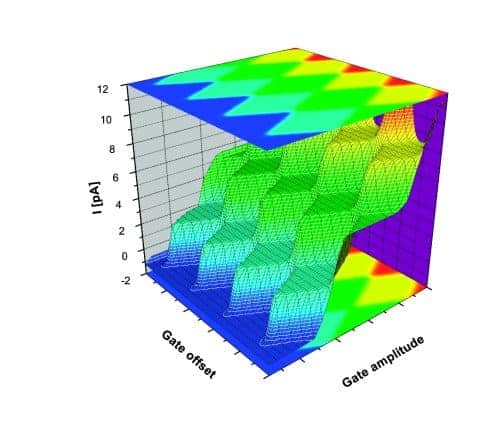
There could soon be a new and more accurate method of defining the standard unit of current, the ampere, thanks to a tiny electronic device built by physicists in Finland and the US. The team, led by Jukka Pekola of the Helsinki University of Technology, has made a single-electron transistor that converts an oscillating voltage into a very precise electrical current.
The ampere, volt and ohm are the three fundamental units of electricity. While physicists have devised modern microscopic definitions of the volt and ohm – through measurements of the Josephson voltage and quantum Hall resistance respectively – the most accurate measurements of the ampere are made using a refined version of a technique first developed in the 19th century.
Today, the ampere is defined as the current which, when flowing through two parallel conductors one metre apart, exerts a certain force between the conductors. This is a macroscopic measurement involving a specific geometrical configuration of conductors – which limits the accuracy of the measurement.
Measuring tiny currents
Instead, physicists would like to define the ampere by creating an extremely precise source of electric current capable of delivering one electron at a time. Although researchers have already tried to make such single-electron devices in order to redefine the ampere, none have been successful because detecting such tiny electron currents has proved very difficult.
Now, Pekola and colleagues have made a single-electron transistor that could be used to overcome this problem (Nature Physics doi: 10.1038/nphys808 ). Their device consists of a small conducting island that is connected to two tunnel junctions. Electons can flow into the island via one junction and out via the other. The device also includes a gate electrode, which can be used to control the flow of electrons through the island by applying a voltage.
Each tunnel junction contains a very thin insulating layer, through which the electrons can quantum mechanically tunnel. The junctions are so tiny that the electric repulsion between electrons prevents more than one electron tunnelling at a time – creating a single-electron device.
Cooled to 0.1 K
The device is cooled to 0.1 K to reduce thermal noise and the team applied a constant voltage across island and junctions. An oscillating voltage is applied to the gate electrode. The precise number of electrons that pass through the device during one cycle of the oscillation is determined by the amplitude and mean value of the gate voltage.
The current flowing through the device is simply the number of electrons that tunnel per gate cycle multiplied by the charge of the electron and the frequency of the gate voltage. The gate frequency and number of electrons per cycle can be determined and the charge on the electron is fixed – which means that the device is a very precise source of current.
Although the researchers still need to improve the accuracy of their device, Pekola believes that the transistor is one of the best candidates to create a “metrological current pump” for defining the ampere. He told physicsworld.com that his could be done by placing about ten of the devices in parallel, which would deliver a current of about 100 pA, which is large enough to measure.
“Our simple one-gate device is easy to operate and it is straightforward to put many devices in parallel to make the output current larger,” said Pekola. “The small current level has been the bottleneck in making single electron current pumps in the past.”
Quantum metrological triangle
The device might also help close the so-called “quantum metrological triangle” that relates current, voltage and resistance. Voltage can be measured using the AC Josephson effect, while resistance can be related through the quantum Hall effect. Both these relationships include the same two fundamental constants — the Planck constant, h and the charge on the electron. A metrological current pump would allow physicists to relate current directly to frequency.
“The result looks very interesting and may be important if it achieves its promise of providing a reliable way of making accurate devices that can both pump more than one electron per cycle and be placed in parallel,” said Ian Robinson of the National Physical Lab in the UK. Robinson works on the “watt balance” that will contribute to setting the values of h and e in new definitions of the SI kilogram and ampere. The apparatus presently uses the Josephson and Quantum Hall effects to measure current with an uncertainty of about 1 x 10-8. “The technique described here has around a factor of 1 million to go before it approaches the 1 x 10-8 level but it shows promise,” he added.



